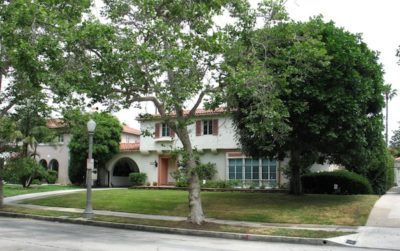McAvoy on Preservation: Preservation policies are strong, leadership is lacking

THERE ARE TOO few planners to service the needs of homeowners in the Historic Preservation Overlay Zones. Above, a home in the Hancock Park HPOZ.
We have a process, but . . .
How do we as citizens help to preserve the iconic individual structures and significant historic neighborhoods in Los Angeles? Seems a simple question, right? Provide processes for protection and make sure that advocates and the city work together to achieve preservation goals in adopted plans and policies. Make the processes accessible and educate the public as to the quality of life and economic benefits of said endeavors.
In Los Angeles, we’ve been working on this for over 50 years. Each decade has seen improvement from policy, process, and educational standpoints. Just over 10 years ago, the preservation process was fragmented, with Historic-Cultural Monument (HCM) designation the responsibility of the Cultural Heritage Commission housed in the Cultural Affairs Department, and the administration of Historic Preservation Overlay Zones (HPOZs) in the Planning Dept.
Consolidated at last
The creation of the Office of Historic Resources (OHR) in the Dept. of City Planning and the move of the administration of the Cultural Heritage Commission to Planning, consolidated preservation planning in Los Angeles. The 2000 adoption of the Cultural Heritage Master Plan, changes in CEQA, Los Angeles becoming a Certified Local Government, and the creation of HistoricPlacesLA, or HPLA (the city’s historic resources inventory and management system), provided a framework to make protection of historic resources throughout the city a (seemingly) achievable goal.
As Janet Hansen, deputy manager of OHR, stated recently in the Los Angeles Conservancy’s newsletter, “HPLA is now the most advanced historic resources management system in the United States… and makes historic resource information fully accessible and searchable.” Resources can be mapped, evaluated within a particular theme/context or time period, and their significance included in project review and planning. Current efforts for the adoption of the Hollywood Community Plan include a chapter on preservation planning. We can be truly proud of these achievements.
Problems persist
And yet… even with all this, it seems increasingly difficult these days to save a historic building, get property owners the incentives they need to care for their properties, and designate identified properties through the HCM or HPOZ process. Currently, it takes well over six months to process an individual HCM nomination, and years to formulate an HPOZ. Staff can only process enough applications for the Cultural Heritage Commission to meet once a month. Nothing nefarious is at work here. There are simply too few people assigned to the task. OHR has a staff of five; there are currently too few HPOZ planners to service the needs of homeowners in the HPOZ districts.
Marcello Vavala of the Los Angeles Conservancy states, “As we’ve seen repeatedly in recent years, the Mayor’s proposed annual budget regularly fails to allocate necessary funds for the continued staffing and expansion of planning staff in OHR’s HPOZ unit.”
The Conservancy, Hollywood Heritage and others continuously advocate for more preservation positions. There certainly is not a lack of trained professionals to do the work; USC’s Heritage Conservation program and others across the country graduate scores of students per year. There are over a dozen historic preservation private consulting firms in the city, and at least that many individual architectural historians who can prepare nominations, assist the city in evaluation, or review Mills Act applications. Nonprofits invest considerable resources in providing training for people to write nominations or even hire professionals themselves. In short, more people are trying to use the process, and they are becoming increasingly frustrated.
Relief is needed
And yet, the logjam persists. Rather than attacking the efforts of the current staff, we need to explore how to provide relief. Each City Council district now contains hundreds of identified yet currently undesignated resources. The Council should work with the Planning Department to find solutions to this dilemma. Buildings are at risk. Neighborhoods which qualify for HPOZ status continue to have contributors demolished. Many neighborhoods which used to qualify now no longer do so because too many contributors have been demolished and replaced with new construction. The resources are identified; the policies and processes are in place. But it’s just not enough to acknowledge the existence of these buildings and to provide a process on paper without the people in place to do the work. HPLA, as the most advanced system in the U.S., should not be known in a few years for its ability to document the attrition. Better to document preservation. Where is the leadership on this issue?
By Christy McAvoy
Christy Johnson McAvoy, a former president both of the Los Angeles Conservancy and the California Preservation Foundation, as well as an Advisor to the National Trust for Historic Preservation, founded Historic Resources Group in Hollywood.
Category: Real Estate


